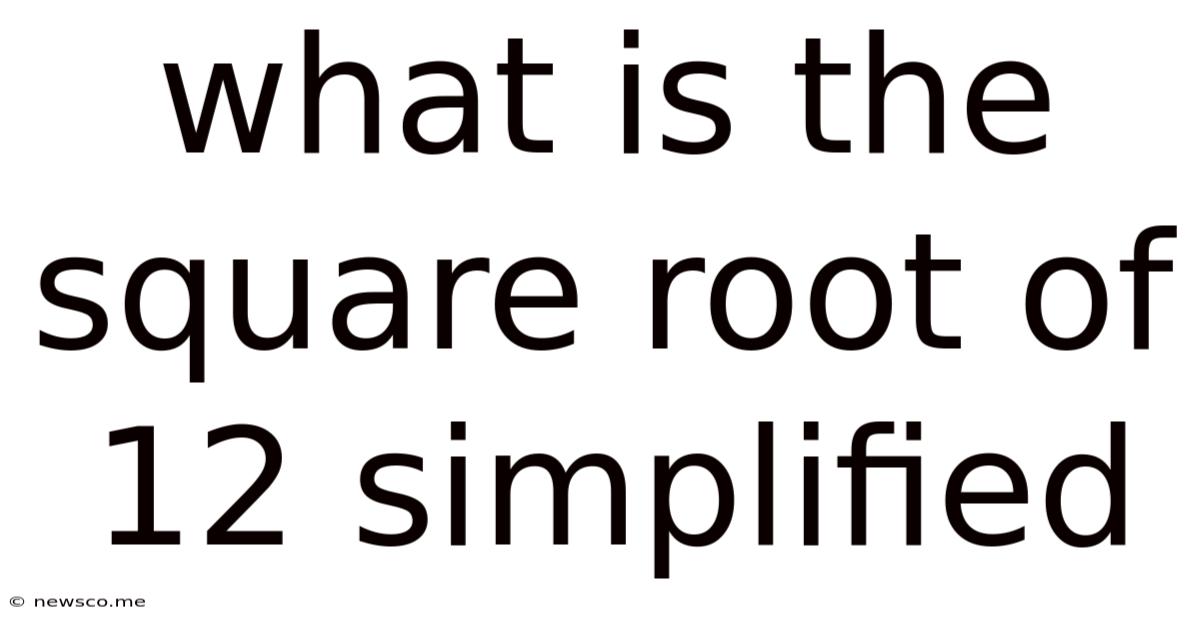What Is The Square Root Of 12 Simplified
News Co
May 08, 2025 · 4 min read

Table of Contents
What is the Square Root of 12 Simplified? A Comprehensive Guide
The square root of 12, often written as √12, isn't a whole number. This means it's an irrational number, a number that can't be expressed as a simple fraction. However, we can simplify it to a more manageable form. This guide will explore how to simplify √12, delve into the underlying mathematical principles, and provide you with a solid understanding of square roots and simplification techniques.
Understanding Square Roots
Before diving into the simplification of √12, let's solidify our understanding of square roots. A square root of a number 'x' is a value that, when multiplied by itself, equals 'x'. For example:
- The square root of 9 (√9) is 3, because 3 x 3 = 9.
- The square root of 16 (√16) is 4, because 4 x 4 = 16.
However, many numbers don't have whole number square roots. This is where simplification comes in handy.
Prime Factorization: The Key to Simplification
The key to simplifying square roots like √12 lies in prime factorization. Prime factorization is the process of breaking down a number into its prime factors – numbers that are only divisible by 1 and themselves (e.g., 2, 3, 5, 7, 11, etc.).
Let's find the prime factorization of 12:
12 can be broken down as follows:
12 = 2 x 6 6 = 2 x 3
Therefore, the prime factorization of 12 is 2 x 2 x 3, or 2² x 3.
Simplifying √12 using Prime Factorization
Now that we have the prime factorization of 12 (2² x 3), we can simplify √12:
√12 = √(2² x 3)
Using the property of square roots that √(a x b) = √a x √b, we can rewrite the expression:
√12 = √2² x √3
Since √2² is simply 2 (because 2 x 2 = 4, and √4 =2), we get:
√12 = 2√3
Therefore, the simplified form of √12 is 2√3. This is the most simplified form because 3 is a prime number and cannot be further broken down.
Visualizing the Simplification
Imagine a square with an area of 12 square units. We can't easily construct a square with sides of a whole number length because 12 is not a perfect square. However, we can think of it as two smaller squares. One square has sides of length 2 (area 4) and another rectangle with an area of 8. This is a visualization of the prime factorization method, although it doesn't offer the same precision for more complex square roots.
Working with Other Square Roots
The same principle applies to simplifying other square roots. Let's consider a few examples:
Example 1: Simplifying √48
-
Prime Factorization: 48 = 2 x 24 = 2 x 2 x 12 = 2 x 2 x 2 x 6 = 2 x 2 x 2 x 2 x 3 = 2⁴ x 3
-
Simplification: √48 = √(2⁴ x 3) = √2⁴ x √3 = 4√3
Example 2: Simplifying √75
-
Prime Factorization: 75 = 3 x 25 = 3 x 5 x 5 = 3 x 5²
-
Simplification: √75 = √(3 x 5²) = √3 x √5² = 5√3
Example 3: Simplifying √108
-
Prime Factorization: 108 = 2 x 54 = 2 x 2 x 27 = 2 x 2 x 3 x 9 = 2 x 2 x 3 x 3 x 3 = 2² x 3³
-
Simplification: √108 = √(2² x 3³) = √2² x √3³ = 2√(3² x 3) = 2 x 3√3 = 6√3
Beyond Simplification: Approximating Irrational Numbers
While 2√3 is the simplified form, it's still an irrational number. This means its decimal representation goes on forever without repeating. To get an approximate value, you can use a calculator:
2√3 ≈ 3.464
Applications of Square Roots
Understanding square roots and their simplification is crucial in various fields, including:
- Geometry: Calculating distances, areas, and volumes often involves square roots (e.g., using the Pythagorean theorem).
- Physics: Solving problems related to motion, energy, and waves frequently requires working with square roots.
- Engineering: Design and construction projects rely on precise calculations, and square roots are integral to many of these calculations.
- Computer Graphics: Creating realistic images and animations often involves manipulating mathematical expressions that include square roots.
Advanced Concepts: Rationalizing the Denominator
In more advanced mathematical contexts, you might encounter expressions with a square root in the denominator of a fraction. In such cases, a technique called rationalizing the denominator is used to remove the square root from the denominator, making the expression easier to work with. This typically involves multiplying both the numerator and denominator by the conjugate of the denominator (e.g., if the denominator is 2 - √3, the conjugate is 2 + √3).
Conclusion: Mastering Square Root Simplification
Simplifying square roots is a fundamental skill in mathematics with applications across various disciplines. By mastering prime factorization and understanding the properties of square roots, you can confidently simplify expressions and solve problems involving these essential mathematical concepts. Remember that the simplified form is the most efficient and elegant way to represent an irrational square root, making further calculations cleaner and more understandable. The techniques described here provide a robust foundation for tackling more complex mathematical challenges involving square roots. Continue practicing, and you'll become proficient in simplifying square roots and solving related problems with ease.
Latest Posts
Related Post
Thank you for visiting our website which covers about What Is The Square Root Of 12 Simplified . We hope the information provided has been useful to you. Feel free to contact us if you have any questions or need further assistance. See you next time and don't miss to bookmark.